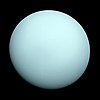Sycorax (moon)
| Discovery | |
|---|---|
| Discovered by | Philip D. Nicholson, Brett J. Gladman, Joseph A. Burns, John J. Kavelaars |
| Discovery date | September 6, 1997 |
| Orbital characteristics | |
Mean orbit radius | 12,179,000 km |
| Eccentricity | 0.5224 |
| 1288.28 d | |
| Inclination | 159° (to the ecliptic)[1] |
| Satellite of | Uranus |
| Physical characteristics | |
Mean radius | 12,179,000 km |
| ~70,000 km² (estimate) | |
| Volume | ~1,800,000 km³ (estimate) |
| Mass | ~5.4×1018 kg (estimate) |
Mean density | ~1.5 g/cm³ (estimate) |
| ~0.040 m/s2 (estimate) | |
| ~0.087 km/s (estimate) | |
| Albedo | 0.04 (assumed)[1] |
Sycorax is one of Uranus' moons. It is the biggest retrograde non-spherical one of its moons.
Sycorax was found on September 6, 1997 by Brett J. Gladman, Philip D. Nicholson, Joseph A. Burns, and John J. Kavelaars. They found it using the 200-inch Hale telescope. They also found Caliban. Sycorax was given the designation S/1997 U 2.[2]
Sycorax was confirmed as Uranus XVII. It was named after Sycorax, Caliban's mother in William Shakespeare's play The Tempest.
Orbit[change | change source]

Sycorax follows a far orbit, more than 20 times farther from Uranus than the farthest regular moon Oberon. Its orbit is retrograde, moderately inclined and eccentric.
The orbital parameters suggest that it may belong, together with Setebos and Prospero, to the same dynamic cluster, suggesting common origin.[3]
The diagram illustrates the orbital parameters of the retrograde non-spherical moons of Uranus (in polar co-ordinates) with the eccentricity of the orbits represented by the segments extending from the pericentre to the apocentre.
Physical characteristics[change | change source]
The diameter of Sycorax is estimated at 150 km (assuming albedo of 0.04)[1] making it the biggest non-spherical moon of Uranus, comparable in size with Himalia, the biggest non-spherical moon of Jupiter.
The rotation period could not be estimated well (best fit ~4 h).
Related pages[change | change source]
References[change | change source]
- ↑ 1.0 1.1 1.2 Scott S. Sheppard, David C. Jewitt, and Jan Kleyna An Ultradeep Survey for Irregular Satellites of Uranus: Limits to Completeness, The Astronomical Journal, 129 (2005), pages 518–525 . Preprint
- ↑ GLADMAN, NICHOLSON, BURNS, KAVELAARS, MARSDEN, WILLIAMS & OFFUTT Discovery of two distant irregular moons of Uranus, Nature, 392 (1998), pp. 897 - 899
- ↑ Grav, Tommy; Holman, Matthew J.; Gladman, Brett J.; Aksnes, Kaare Photometric survey of the irregular satellites,Icarus, 166,(2003), pp. 33-45. Preprint

